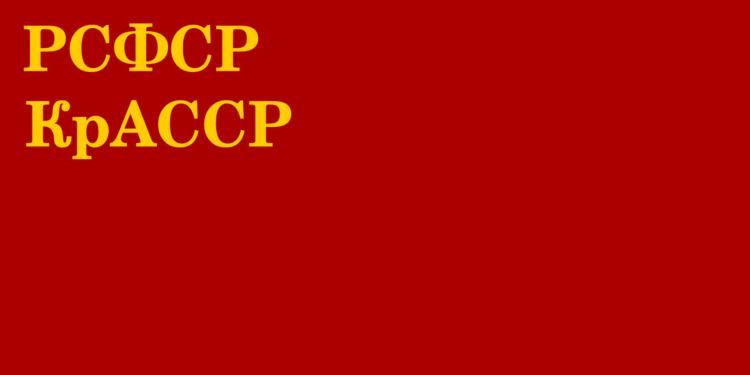1921–1942
1943–1945
1991–1992 →
→
→ Established October 18, 1921 Disestablished 6 May 1992 | Capital Simferopol Re-established February 12, 1991 | |
 | ||
Government Autonomous Soviet Socialist Republic | ||
Crimean Autonomous Soviet Socialist Republic (Modern Crimean Tatar: Qırım Muhtar Sotsialist Sovet Cumhuriyeti; Official Crimean Tatar name in the Uniform Turkic Alphabet: Qrьm Avonomjalь Sotsialist Sovet Respublikasь; Russian: Крымская Автономная Социалистическая Советская Республика Krymskaya Avtonomnaya Socialisticheskaya Sovetskaya Respublika) was an Autonomous Soviet Socialist Republic of the Russian SFSR located in the Crimean Peninsula.
Contents
History
It was created on October 18, 1921 as the Crimean Autonomous Socialist Soviet Republic of the Russian SFSR. It was renamed the Crimean Autonomous Soviet Socialist Republic on December 5, 1936 by the VIII Extraordinary Congress of Soviets of the USSR.
Crimea was under de facto control of Nazi Germany from September 1942 to October 1943, administratively incorporated into Reichskommissariat Ukraine as Teilbezirk Taurien. Alfred Frauenfeld was appointed as General Commissar (although it seems that Frauenfeld spent most of his time in Crimea researching the peninsula's Gothic heritage and the actual government was in the hands of Erich von Manstein).
In 1944, under the pretext of alleged collaboration of the Crimean Tatars with the Nazi occupation regime, the Soviet government on orders of Joseph Stalin and Lavrentiy Beria deported the Crimean Tatar people from Crimea.
Actual collaboration in the military sense had been rather limited, with a recorded 9,225 Crimean Tatars serving in anti-Soviet Tatar Legions and other German formed battalions, but there was in fact a surprisingly high degree of co-operation between the occupation government and the local administration; this has been significantly due to Frauenfeld's unwillingness to implement the policy of brutality towards the local population pursued by Reichskommissar Erich Koch, which led to a series of public conflict between the two men. The constitutional rights of the forcibly-resettled Tatars were restored with a decree dated September 5, 1967, but they were not allowed to return until the last days of the Soviet Union.
The Crimean ASSR was converted into the Crimean Oblast of the RSFSR on June 30, 1945 by the decree of the both presidiums of the Supreme Soviet of USSR and the Supreme Soviet of RSFSR (published on May 26, 1946), and the Crimean Oblast was transferred to the Ukrainian SSR in 1954.
The ASSR was re-established on February 12, 1991 by the Supreme Soviet of the Ukrainian SSR following a referendum held on January 20, 1991, and it became the Autonomous Republic of Crimea, part of the newly independent state of Ukraine, effective May 6, 1992.
Administrative divisions
With the establishment of autonomous republic it was divided into seven okrugs from 1921 to 1923.
